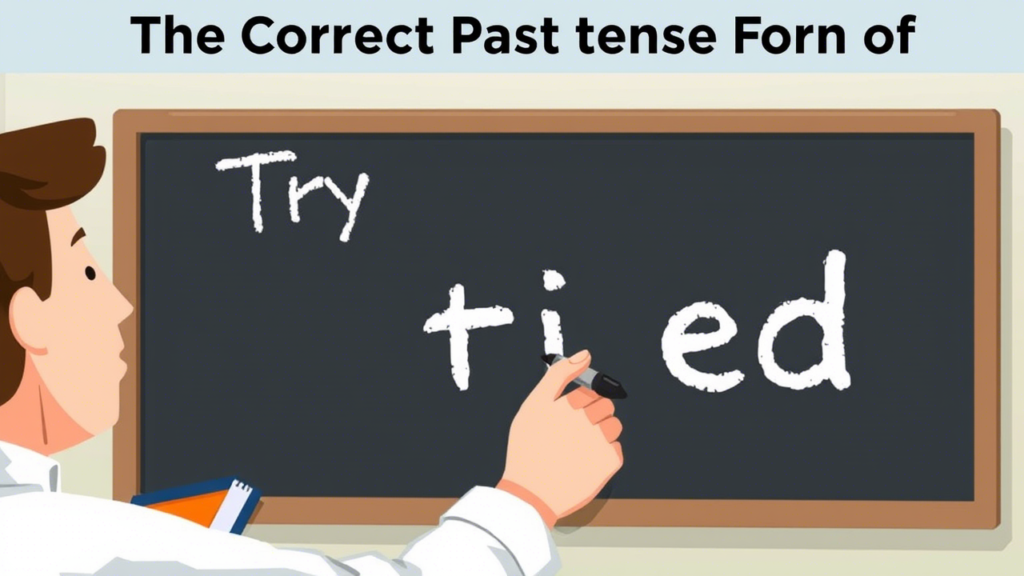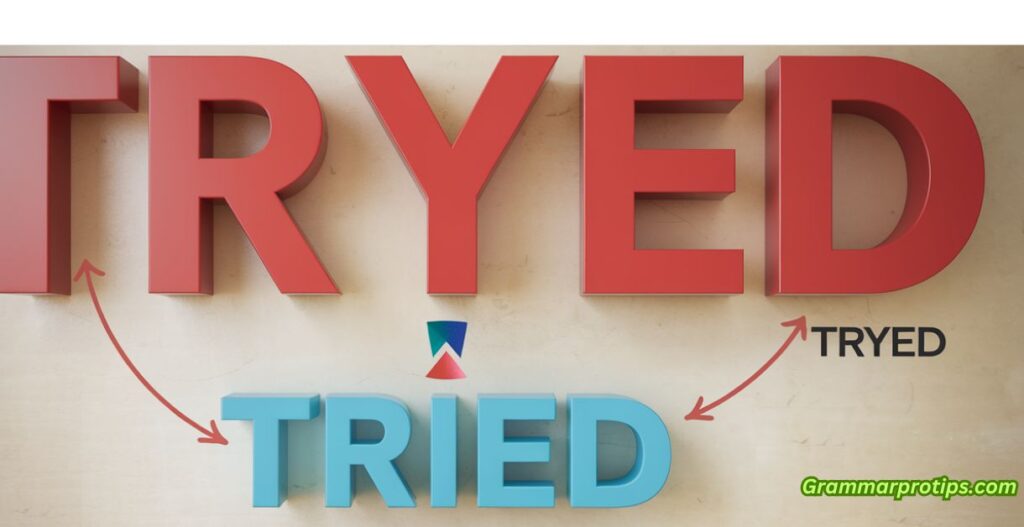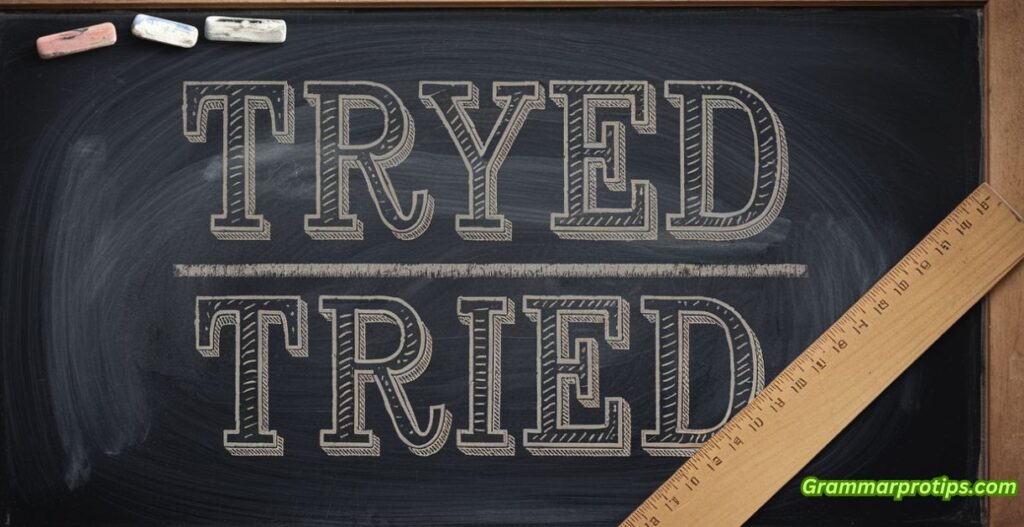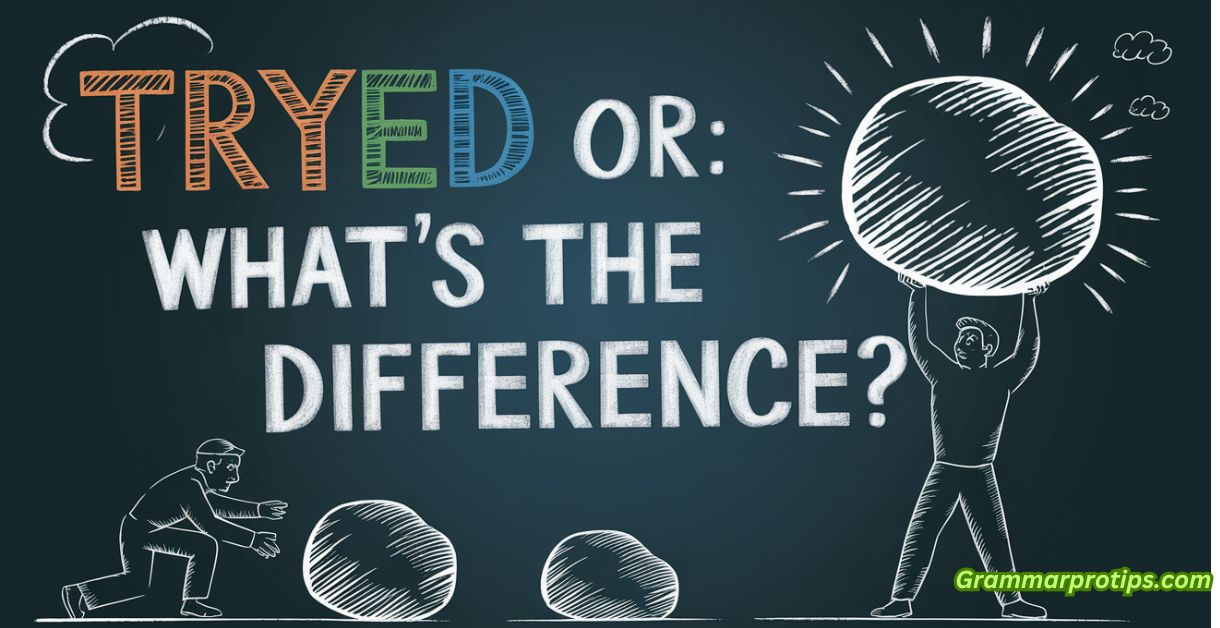When it comes to mastering the English language, even small details like spelling can make a big difference. One common point of confusion is whether to use tried or tryed.
If you’ve ever wondered, “What is the meaning of tryed?” or “When to use tried or tryed?”you’re not alone. Many people struggle with this question because it seems logical to add an -ed to words ending in y. However, English grammar has specific rules that govern such cases.
The Correct Past Tense Form of Try

Let’s start by addressing the elephant in the room: What does “I tried” mean? Simply put, tried is the past tense of the verb try. It indicates an action that was attempted in the past but may or may not have succeeded. For example:
- I tried calling Sarah yesterday, but she didn’t answer.
- We tried fixing the leak ourselves, but it got worse.
So, why isn’t it spelled as tryed? The reason lies in English grammar rules. Verbs ending in a consonant followed by y (like try) change the y to i before adding -ed. This rule ensures proper pronunciation and clarity. Therefore, the correct form is always tried, never tryed. Understanding this distinction is crucial for maintaining proper English grammar.
Common Spelling Mistake Alert
Using tryed instead of tried is one of the most frequent spelling errors in English. While it might seem intuitive to simply tack on -ed, doing so violates established grammatical conventions. To avoid falling into this trap, remember the golden rule: Change the y to i when forming the past tense of verbs ending in a consonant + y.
Grammar Rules for Verbs Ending in Y
To fully grasp when to use tried or tryed, let’s examine the broader context of verb forms in English. There are two main categories of verbs ending in y: those preceded by a vowel and those preceded by a consonant.
- Verbs ending in a vowel + y (e.g., play, enjoy): These remain unchanged when forming the past tense.
- Example: She played soccer last weekend.
- Example: They enjoyed their vacation immensely. Tried vs Tryed
- Verbs ending in a consonant + y (e.g., try, cry): Here, the y changes to i before adding -ed.
- Example: He cried during the movie.
- Example: I tried baking a cake for the first time. Tried vs Tryed
These distinctions are essential for anyone looking to improve their English language writing tips and avoid unnecessary mistakes.
Tried vs Tryed: A Closer Look
Now that we’ve clarified the grammatical foundation, let’s compare tried and tryed more closely. Below is a table summarizing key differences:
| Term | Correct Spelling | Meaning | Usage Example |
|---|---|---|---|
| Tried | Yes | Past tense of try | I tried solving the puzzle. |
| Tryed | No | Incorrect spelling | N/A |
As shown above, tryed doesn’t exist in standard English vocabulary. Instead, it represents an incorrect spelling of tryed often resulting from verb tense confusion.
Practical Scenarios: Using Tried in Context
To reinforce these concepts, here are some real-world scenarios where tried fits perfectly. Each example demonstrates how to apply the word naturally in different formats, including emails and conversations.
Scenario 1: Email Communication
Imagine you’re drafting an email to your colleague, Alex, about a recent project update. Here’s how you could incorporate tried effectively:
Subject: Follow-Up on Project Proposal
Hi Alex,
I wanted to give you a quick update on the proposal we discussed last week. I tried reaching out to the client yesterday, but unfortunately, they haven’t responded yet. In the meantime, I reviewed the document again and made a few minor edits. Let me know if you’d like to review them together.
Best regards,
Jordan
Notice how the sentence flows smoothly without sounding robotic. Including tried adds authenticity while adhering to proper English grammar.
Scenario 2: Casual Conversation
Picture yourself chatting with a friend over coffee. You might say something like:
- “Hey, I tried making sushi at home last night—it was harder than I thought!”
- “Yeah, I tried watching that new series everyone’s talking about, but I couldn’t get into it.”
These examples highlight what is the meaning of trying or tried in everyday speech. They convey effort and past attempts in relatable ways.
Synonyms for Tried: Expanding Your Vocabulary
While tried is versatile, sometimes using synonyms can enhance your writing. Here are a few alternatives depending on the context:
- Attempted
- Tested
- Endeavored
- Struggled
- Experimented
For instance:
- Instead of saying, “I tried climbing the mountain,” you could say, “I attempted climbing the mountain.”
- Or, “She tested the recipe before serving it to guests.”
Incorporating synonyms helps diversify your language and keeps readers engaged.
Avoiding Spelling Mistakes: Tips for Success

Spelling errors can undermine your credibility, especially in professional settings. To ensure you never mistakenly write tryed again, follow these language learning tips:
- Practice Regularly: Write sentences using irregular verbs daily to build muscle memory.
- Use Tools Wisely: Leverage spell-checkers and grammar apps like Grammarly to catch errors early.
- Review Grammar Rules: Revisit foundational principles like verb forms in English to solidify your knowledge.
- Read Widely: Exposure to well-written texts improves familiarity with correct usage patterns.
By adopting these strategies, you’ll boost your English writing confidence and minimize spelling errors in English.
What Is Tried in Grammar?
From a technical standpoint, tried functions as both a regular verb and a transitive/intransitive verb. Its role depends on the sentence structure:
- As a transitive verb: It requires a direct object.
- Example: She tried the soup and loved it.
- As an intransitive verb: It stands alone without needing an object.
- Example: He tried, but it wasn’t enough.
Understanding these nuances strengthens your grasp of English grammar and spelling.
Past Action Expressions: Why Tried Matters

Expressing past actions accurately is vital for effective communication. Whether you’re describing personal experiences or documenting historical events, choosing the right verb form matters. Consider these examples:
- Historical Account: “The scientists tried numerous experiments before discovering penicillin.”
- Personal Reflection: “Last summer, I tried hiking Mount Everest Base Camp—it was life-changing.”
Both sentences rely on tried to convey completed efforts, emphasizing its importance in storytelling and factual reporting.
Conclusion: Mastering Tried vs Tryed
In conclusion, mastering the difference between tried and tryed boils down to understanding basic grammar rules for verbs ending in y. Remember, tried is the only acceptable past tense form of try, while tryed is an incorrect spelling born out of misunderstanding. By practicing regularly and applying the tips shared here, you’ll eliminate common spelling mistake risks and elevate your writing skills.
Next time someone asks, “What is the past tense of ‘tried’?” or “What is the meaning of trying or tried?”—you’ll know exactly what to say. Keep refining your craft, stay mindful of improper English grammar, and watch your confidence soar!
Final Thought
Language evolves, but core principles remain constant. Embrace the challenge of learning, and don’t hesitate to revisit foundational topics like tried vs tryed whenever needed. After all, every step toward improvement counts!

“Smith is the dedicated admin of [grammarprotips.com], a platform focused on enhancing grammar skills. With a passion for language and education, Smith strives to make grammar accessible and enjoyable for learners of all levels. Committed to delivering high-quality content, Smith continually explores innovative ways to help users master the complexities of grammar.”


2w0ll5